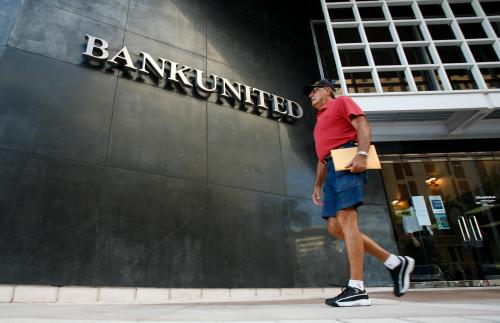At the height of the financial crisis a decade ago, economists and policymakers underestimated the depth and severity of the recession that would follow. I argue in a paper released today by the Brookings Papers on Economic Activity (BPEA) that remedying this failure demands a more thorough inclusion of credit-market factors in models and forecasts of the economy. I also provide new evidence that suggests that the severity of the Great Recession reflected in large part the adverse effects of the financial panic on the supply of credit. In particular, the housing bust alone can’t explain why the Great Recession was as bad as it was.
Economists have described two primary channels through which the financial crisis of a decade ago depressed economic activity: (1) a buildup in household debt in the early 2000s which, in combination with the collapse of housing prices, dampened household spending; and (2) fragilities in the financial system, including excessive risk-taking and reliance on short-term wholesale funding, which resulted in a panic and credit crunch. The two channels overlap, but the relative importance of each to the real economy has implications for financial regulation and for policymakers’ response to future crises.
The starting point for understanding both channels, and the role of credit-market factors in macroeconomics more generally, is the recognition that there is a cost associated with connecting lenders to creditworthy borrowers. Lenders have less-than-perfect information about potential borrowers and so must bear the costs of screening and evaluating them, and of monitoring them after making the loan. These costs add up to an external finance premium, the difference between the all-in cost of funding a risky private borrower and the cost of lending to a perfectly safe borrower like the U.S. government. In general, the size of the external finance premium depends on the financial health of both borrowers and lenders. For example, a borrower with good collateral and a sizable down payment is cheap to lend to, being very likely to repay, while a bank with a large capital cushion can attract the funding it needs at lower cost. By the same token, declines in the aggregate financial health of borrowers or lenders increase the cost of extending credit, dampen investment and consumption, and slow the economy. For both channels—one related to the health of household balance sheets, the other to disruptions in credit intermediation—the key to understanding their real effects lies in tracing their impacts on the cost and availability of credit.
Recent work, including by Atif Mian and Amir Sufi, proposes that the accumulation of debt during the housing boom of the early 2000s made households particularly vulnerable to changes in their net worth. When house prices began to decline, homeowners’ main source of collateral (home equity) contracted, reducing their access to new credit even as their wealth and incomes declined. These credit constraints exacerbated the declines in consumer spending. In effect, the external finance premium faced by households rose sharply. Mian and Sufi and others attribute the economic downturn in 2008 and 2009 primarily to the boom and subsequent bust in housing wealth, together with the associated deleveraging and spending reductions by households. This narrative captures the important relationship between borrower balance sheets and the real economy while de-emphasizing the turmoil in financial markets that grabbed the most headlines.
The second channel through which the crisis led to a recession was a severe financial panic – a system-wide run on providers of credit, including banks but also, importantly, nonbank lenders like investment banks and finance companies. In normal times, banks and other intermediaries make loans and hold most of the credit risk on their balance sheets. Providers of credit finance their lending by issuing safe, mostly short-term liabilities, including not only old-school demand deposits (in the case of banks) but also so-called wholesale forms of funding, such as commercial paper and repurchase agreements (or “repos”), which are a form of short-term, collateralized loans. Before the crisis, investors were happy to provide wholesale funding, even though it was not government insured, because such assets were liquid and perceived to be quite safe. Banks and other intermediaries liked the low cost of wholesale funding and the fact that it appealed to a wide class of (mostly institutional) investors. Credit intermediaries’ reliance on wholesale funding grew rapidly in the years leading up to the crisis.
Panics emerge when news leads investors to believe that the “safe” short-term assets they have been holding may not, in fact, be entirely safe. If the news is bad enough, investors will pull back from funding banks and other intermediaries, refusing to roll over their short-term liabilities as they mature. As intermediaries lose funding, they may be forced to sell existing loans and to stop making new ones, driving up the external finance premium. The cost of financing any project—buying a house or car or making a business investment—will spike, slowing the economy.
Panic-type phenomena occurred in a variety of contexts after a series of revelations about the riskiness of subprime mortgage-related assets in the summer of 2007. One problem was that dicey subprime mortgages had been combined with other types of credit in complicated securities, so that investors lost confidence not only in subprime but in almost all types of securities backed by private credit. Runs occurred on a variety of forms of financing, including asset-backed commercial paper, structured investment vehicles and other conduits, securities lending, and money market funds. The repo market, which was critical for the daily financing operations of many intermediaries, especially investment banks, was hit particularly hard. Eventually, runs and the contraction in funding generated broad selloffs on numerous other securities unrelated to the housing market, like corporate bonds and securities backed by student loans and credit cards. This spread of the panic to non-mortgage credit caused the external finance premium to spike for both households and firms, with potentially severe effects on the real economy (see Gertler and Kiyotaki, 2015).
Prior to the crisis, the macroeconomic models used by central banks and forecasters—including the Fed’s workhorse model—provided little guidance on how to think about the economic effects of credit-market disruptions. Fed staff and policymakers accordingly under-predicted the depth and duration of the recession. For example, in October 2008, when the financial panic was at its most intense, the Fed staff predicted that unemployment would peak at a little above 7 percent; in reality, it would reach 10 percent by the fall of 2009. Other forecasters also underestimated the impact of the crisis. As I discuss in my paper, the crisis significantly changed economists’ views on the importance of credit factors in the economy at large, and during the past decade, much interesting new research has documented the importance of those factors and shown how to incorporate them into macroeconomic forecasting and analysis. But there is still much progress to be made.
New Evidence
A principal goal of my paper is to study the relative importance of the two potential channels by which the crisis affected the economy: the channel working through household balance sheets and the channel related to the financial panic. To study the relative importance of the two, I turn to an illustration of the different stages of the financial crisis. The chart below shows some representative financial data, which in turn illustrate four stages of the crisis: the collapse of investor confidence in subprime mortgages, the beginning of broad-based pressures in funding markets, panic and fire sales in the markets for securitized credit (including non-mortgage credit), and the deterioration in the balance sheets of banks and other lenders.
Stages of the Financial Crisis
1 – The Subprime series is the ABX BBB Index, a market-traded index of the value of BBB-rated, 2006-vintage subprime mortgages. Series is in index points (right axis). Source: IHS Markit.
2 – The Bank Solvency series (left axis) shows the spread on 5-year credit default swaps for Bank of America on the left axis, a market measure of the perceived risk of default on the bank’s bonds. Source: IHS Markit.
3 – The Nonmortgage Credit series (left axis) is the option-adjusted spread on the Bloomberg Barclays total return index for asset-backed securities on credit cards, indicating investor’s willingness to hold an important class of non-mortgage credit in securitized form. Source: Bloomberg Finance L.P.
4 – The Funding series (left axis) is the one-month LIBOR-OIS spread, an indicator of short-term funding stress in the interbank lending market and in wholesale funding more generally. Source: Haver Analytics, Bloomberg Finance L.P.
In the figure, the variable marked “Subprime,” derived from an index of market valuations of subprime mortgages (see my paper), shows investors’ developing concerns about the housing market and mortgage-related assets. In this first stage of the crisis, these concerns grew as house prices declined and mortgage delinquencies rose beginning in early 2007.
The variable marked “Funding,” is a measure of stress in the short-term funding markets that banks use to finance their daily operations. The series rose (showing greater stress) in August 2007, after France’s largest investment bank, BNP Paribas, announced it was unable to value the assets in three of its largest investment funds, kicking off the second stage. Funding stress reached its peak following the Lehman Brothers bankruptcy in September 2008 but came down by the end of the year as various government programs took effect.
The third stage of the crisis, shown by the series market “Nonmortgage Credit,” reflects the indiscriminate spread of the panic from mortgage to non-mortgage assets. Funding strains and a general loss of confidence in securities backed by private credit forced investment banks and other lenders to sell large quantities of risky assets, often at fire sale prices.
The final series, labeled as ‘Bank Solvency’ indicates the deteriorating balance sheets of large commercial and investment banks caused by mortgage losses, funding pressures, and fire sales. As this variable shows, in the fourth stage of the crisis, bank health worsened steadily through early 2009 (higher values imply a higher risk of default), improved following regulators’ stress tests of large banks that spring, and worsened again at about the time of the credit downgrade of the U.S. government in 2011 and continuing pressures in Europe.
While these individual data series nicely illustrate the stages of the financial crisis, they are only individual series. How do we know that they are representative? In the analysis of my paper, I use a large set of daily financial data to construct four summary variables, which contain, respectively, information about housing and mortgage markets, short-term wholesale funding, non-mortgage credit, and the balance sheets of banks and other lenders. These summary variables, or “factors,” it turns out, correspond closely to the four stages of the crisis seen in the figure, showing that the basic story is robust. Having estimated the factors, I then use them to ask an important question: What would have happened to GDP and other measures of real economic activity if the housing and mortgage bubble had burst but funding and securities markets had remained reasonably stable? Would the recession have been as deep?
For convenience, I group the four estimated factors into two sets: First, I combine the two factors that reflect the pressures on short-term funding and the fire sales in non-mortgage credit markets and call them “Panic Factors.” These two factors correspond closely to the financial panic that began in the summer of 2007 but became much more intense after the failure of Lehman Brothers and the government rescue of AIG. Second, I combine the factors describing the bust in housing and mortgage markets and the weakening of the balance sheets of banks and other lenders, calling them “Balance Sheet Factors.” The balance sheet factors include the household balance sheet channel described by Mian and Sufi as well as the effects of mortgage losses on lender capital positions. (Excluding the bank solvency factor, leaving only the factor describing housing and mortgage markets, does not change the results.) I then ask how well the two sets of factors predict changes in GDP, industrial production, housing starts, employment, consumption, and other indicators of real activity.
As the illustrative charts below show, the Panic Factors on their own (that is, abstracting from the declines in housing) consistently predict the steep declines in economic growth and other real variables that marked the early stages of the Great Recession, while the Balance Sheet Factors on their own do not predict the downturn. These results indicate that the severity of the recession cannot be explained by a deterioration in housing and consumer finances alone, but in large part reflected the widespread run on short-term funding and securitized credit. They also suggest that policymakers’ aggressive actions to end the financial panic on Wall Street were crucial in preventing an even more devastating blow to Main Street.
Simulations of the Great Recession
Factors related to the financial panic better simulate the recession in the US than do factors related to borrower and lender balance sheets
Although the Balance Sheet factors do not forecast the acute phase of the economic downturn in my setup, that does not mean they were irrelevant. Of course, the bursting of the housing bubble was the spark that ignited the panic in the first place. Moreover, much other evidence (by Mian and Sufi and others) is consistent with the view that household deleveraging contributed both to the initial downturn in spending and to the slowness of the recovery. It may well be that household balance sheets evolve too slowly and smoothly for their effects to be fully accounted for in the type of analysis used in my paper, which tends to emphasize shorter-term fluctuations. But my results do suggest that, in the absence of the panic, the declines in employment, consumption and output in the early stages of the Great Recession would have been significantly less severe.
The panic of 2008 differed from the Great Depression of the 1930s in that the runs on the financial system during the recent episode were on wholesale funding, and occurred electronically, while in the 1930s retail depositors lined up in the streets. But the overall effect was the same: A loss of confidence in credit providers caused the supply of credit to plummet, the external finance premium to spike, and the real economy to contract rapidly. Macroeconomic analysis and forecasting needs to take into account how disruptions to credit markets, in ordinary recessions as well as in financial panics, can damage the real economy.
*Sage Belz and Michael Ng contributed to this post. Graphics and animation by Tyler Wolf.






Commentary
Financial panic and credit disruptions in the 2007-09 crisis
September 13, 2018